Critical Appraisal of Evidence: HLSC122, Semester 1, 2019, Essay
VerifiedAdded on 2022/11/11
|8
|1825
|468
Essay
AI Summary
This essay presents a critical appraisal of a research article that investigated illicit drug use among attendees of music festivals in Australia. The paper examines the authors' qualifications and potential biases, the research questions, design, and methods, including the use of a cross-sectional survey and quantitative data analysis. It also discusses the study's findings, limitations, and the implications for understanding drug use patterns and attitudes toward drug checking services. Furthermore, the essay explores the application of evidence-based practice in the context of the research, specifically addressing a case scenario involving parental concerns about drug use at music festivals. It identifies both individual and organizational barriers to implementing evidence-based practices, such as lack of time and insufficient collaboration among healthcare workers, and concludes by emphasizing the importance of research findings as evidence to inform health practices and awareness.
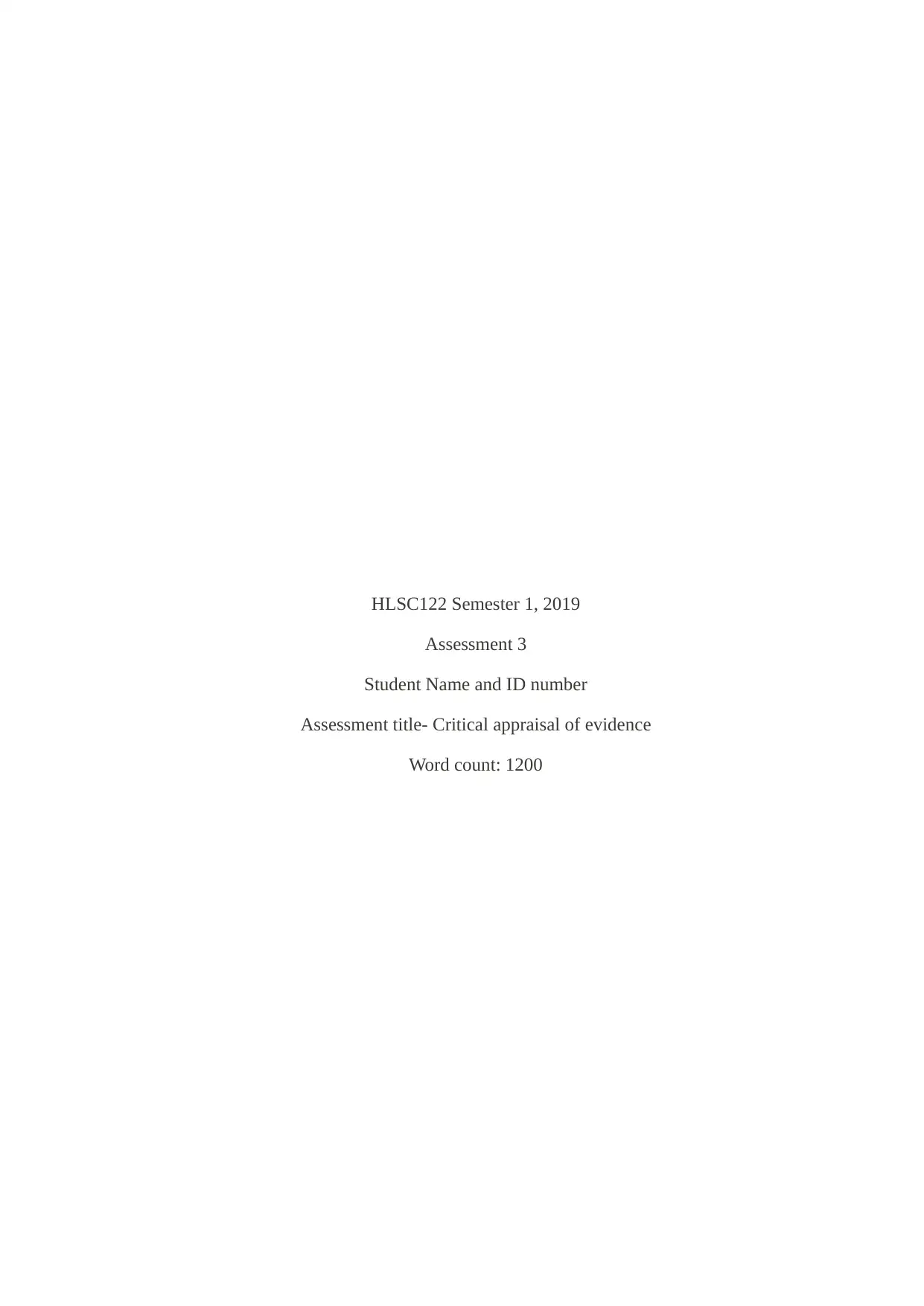
HLSC122 Semester 1, 2019
Assessment 3
Student Name and ID number
Assessment title- Critical appraisal of evidence
Word count: 1200
Assessment 3
Student Name and ID number
Assessment title- Critical appraisal of evidence
Word count: 1200
Paraphrase This Document
Need a fresh take? Get an instant paraphrase of this document with our AI Paraphraser
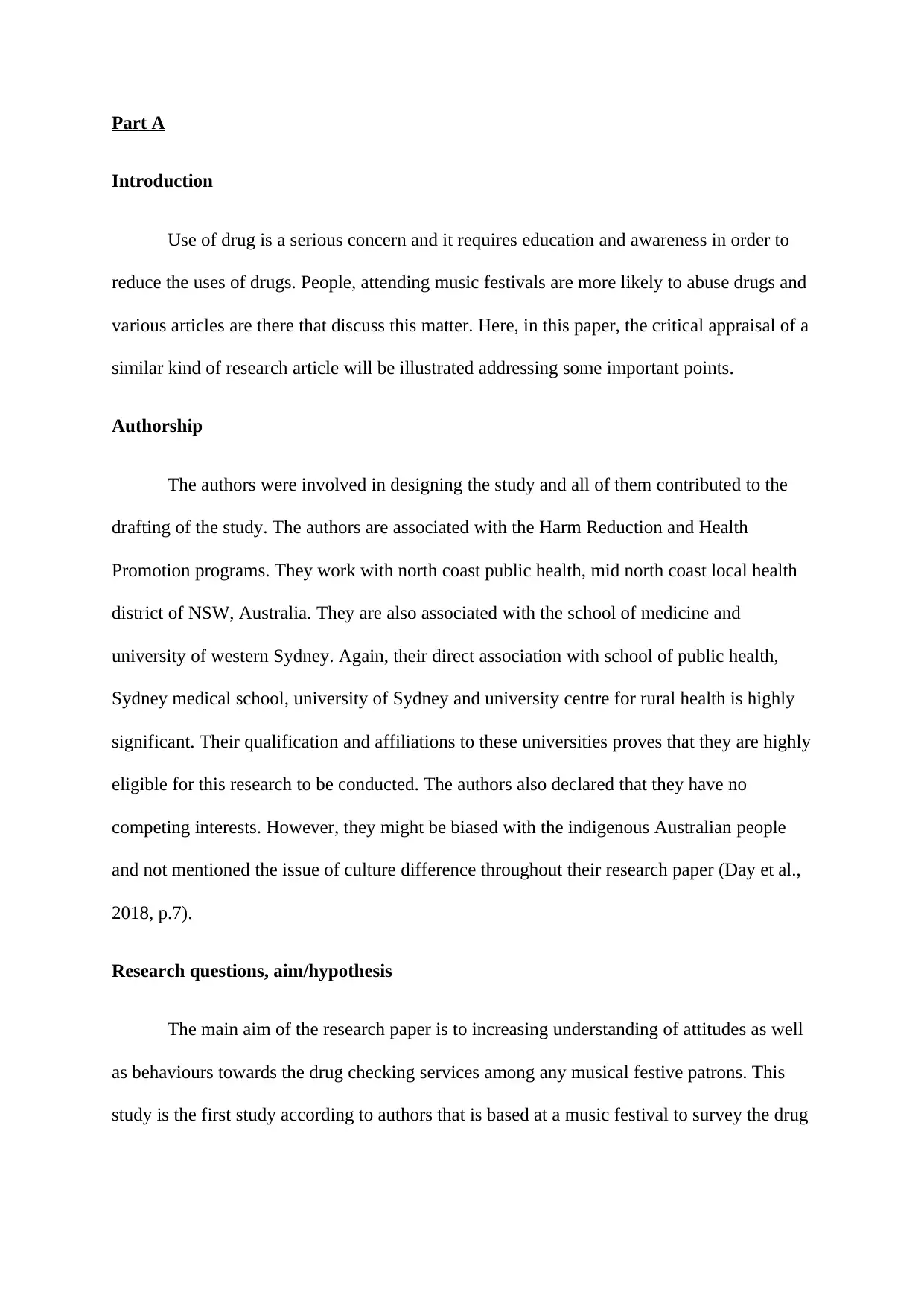
Part A
Introduction
Use of drug is a serious concern and it requires education and awareness in order to
reduce the uses of drugs. People, attending music festivals are more likely to abuse drugs and
various articles are there that discuss this matter. Here, in this paper, the critical appraisal of a
similar kind of research article will be illustrated addressing some important points.
Authorship
The authors were involved in designing the study and all of them contributed to the
drafting of the study. The authors are associated with the Harm Reduction and Health
Promotion programs. They work with north coast public health, mid north coast local health
district of NSW, Australia. They are also associated with the school of medicine and
university of western Sydney. Again, their direct association with school of public health,
Sydney medical school, university of Sydney and university centre for rural health is highly
significant. Their qualification and affiliations to these universities proves that they are highly
eligible for this research to be conducted. The authors also declared that they have no
competing interests. However, they might be biased with the indigenous Australian people
and not mentioned the issue of culture difference throughout their research paper (Day et al.,
2018, p.7).
Research questions, aim/hypothesis
The main aim of the research paper is to increasing understanding of attitudes as well
as behaviours towards the drug checking services among any musical festive patrons. This
study is the first study according to authors that is based at a music festival to survey the drug
Introduction
Use of drug is a serious concern and it requires education and awareness in order to
reduce the uses of drugs. People, attending music festivals are more likely to abuse drugs and
various articles are there that discuss this matter. Here, in this paper, the critical appraisal of a
similar kind of research article will be illustrated addressing some important points.
Authorship
The authors were involved in designing the study and all of them contributed to the
drafting of the study. The authors are associated with the Harm Reduction and Health
Promotion programs. They work with north coast public health, mid north coast local health
district of NSW, Australia. They are also associated with the school of medicine and
university of western Sydney. Again, their direct association with school of public health,
Sydney medical school, university of Sydney and university centre for rural health is highly
significant. Their qualification and affiliations to these universities proves that they are highly
eligible for this research to be conducted. The authors also declared that they have no
competing interests. However, they might be biased with the indigenous Australian people
and not mentioned the issue of culture difference throughout their research paper (Day et al.,
2018, p.7).
Research questions, aim/hypothesis
The main aim of the research paper is to increasing understanding of attitudes as well
as behaviours towards the drug checking services among any musical festive patrons. This
study is the first study according to authors that is based at a music festival to survey the drug
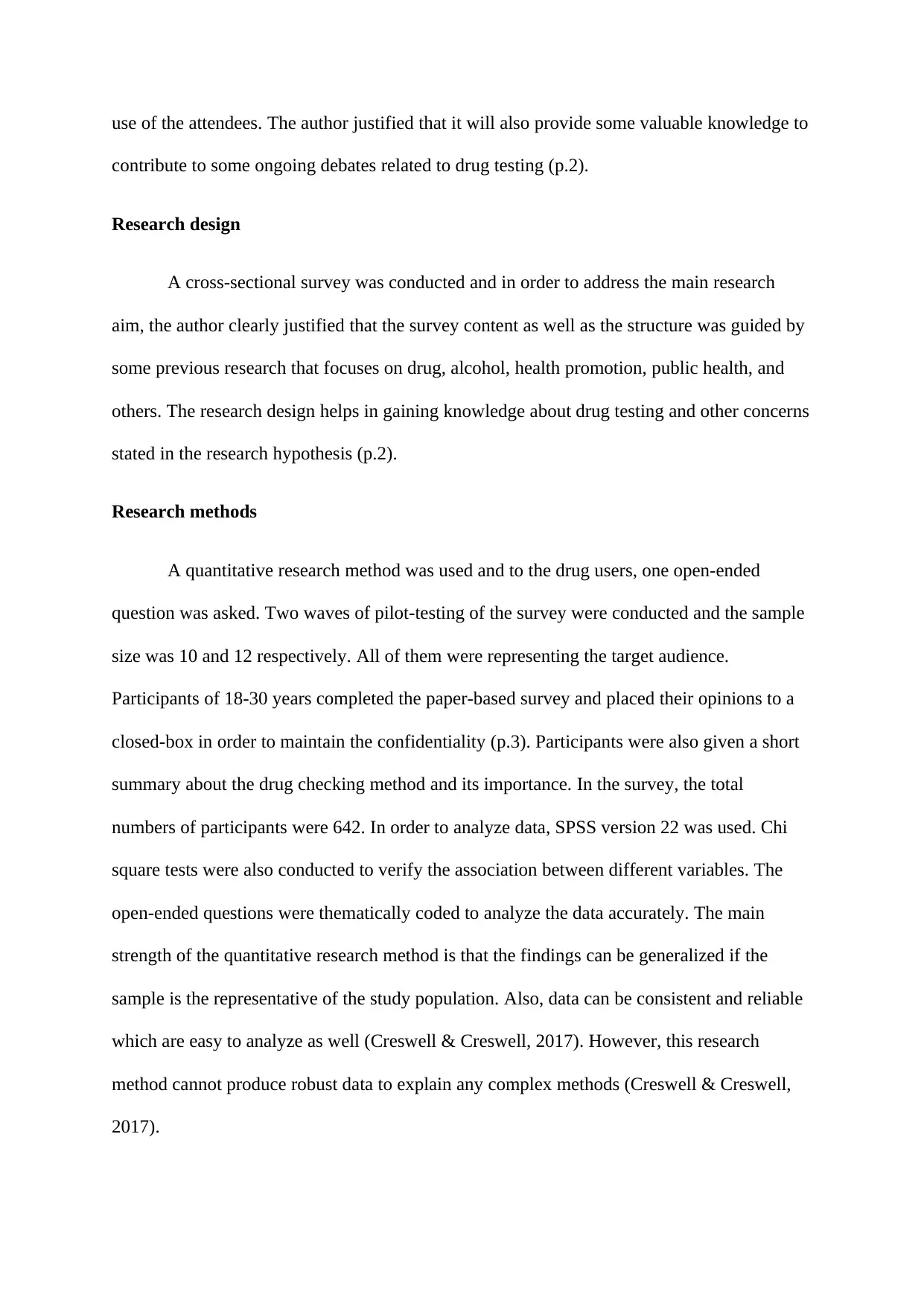
use of the attendees. The author justified that it will also provide some valuable knowledge to
contribute to some ongoing debates related to drug testing (p.2).
Research design
A cross-sectional survey was conducted and in order to address the main research
aim, the author clearly justified that the survey content as well as the structure was guided by
some previous research that focuses on drug, alcohol, health promotion, public health, and
others. The research design helps in gaining knowledge about drug testing and other concerns
stated in the research hypothesis (p.2).
Research methods
A quantitative research method was used and to the drug users, one open-ended
question was asked. Two waves of pilot-testing of the survey were conducted and the sample
size was 10 and 12 respectively. All of them were representing the target audience.
Participants of 18-30 years completed the paper-based survey and placed their opinions to a
closed-box in order to maintain the confidentiality (p.3). Participants were also given a short
summary about the drug checking method and its importance. In the survey, the total
numbers of participants were 642. In order to analyze data, SPSS version 22 was used. Chi
square tests were also conducted to verify the association between different variables. The
open-ended questions were thematically coded to analyze the data accurately. The main
strength of the quantitative research method is that the findings can be generalized if the
sample is the representative of the study population. Also, data can be consistent and reliable
which are easy to analyze as well (Creswell & Creswell, 2017). However, this research
method cannot produce robust data to explain any complex methods (Creswell & Creswell,
2017).
contribute to some ongoing debates related to drug testing (p.2).
Research design
A cross-sectional survey was conducted and in order to address the main research
aim, the author clearly justified that the survey content as well as the structure was guided by
some previous research that focuses on drug, alcohol, health promotion, public health, and
others. The research design helps in gaining knowledge about drug testing and other concerns
stated in the research hypothesis (p.2).
Research methods
A quantitative research method was used and to the drug users, one open-ended
question was asked. Two waves of pilot-testing of the survey were conducted and the sample
size was 10 and 12 respectively. All of them were representing the target audience.
Participants of 18-30 years completed the paper-based survey and placed their opinions to a
closed-box in order to maintain the confidentiality (p.3). Participants were also given a short
summary about the drug checking method and its importance. In the survey, the total
numbers of participants were 642. In order to analyze data, SPSS version 22 was used. Chi
square tests were also conducted to verify the association between different variables. The
open-ended questions were thematically coded to analyze the data accurately. The main
strength of the quantitative research method is that the findings can be generalized if the
sample is the representative of the study population. Also, data can be consistent and reliable
which are easy to analyze as well (Creswell & Creswell, 2017). However, this research
method cannot produce robust data to explain any complex methods (Creswell & Creswell,
2017).
⊘ This is a preview!⊘
Do you want full access?
Subscribe today to unlock all pages.

Trusted by 1+ million students worldwide
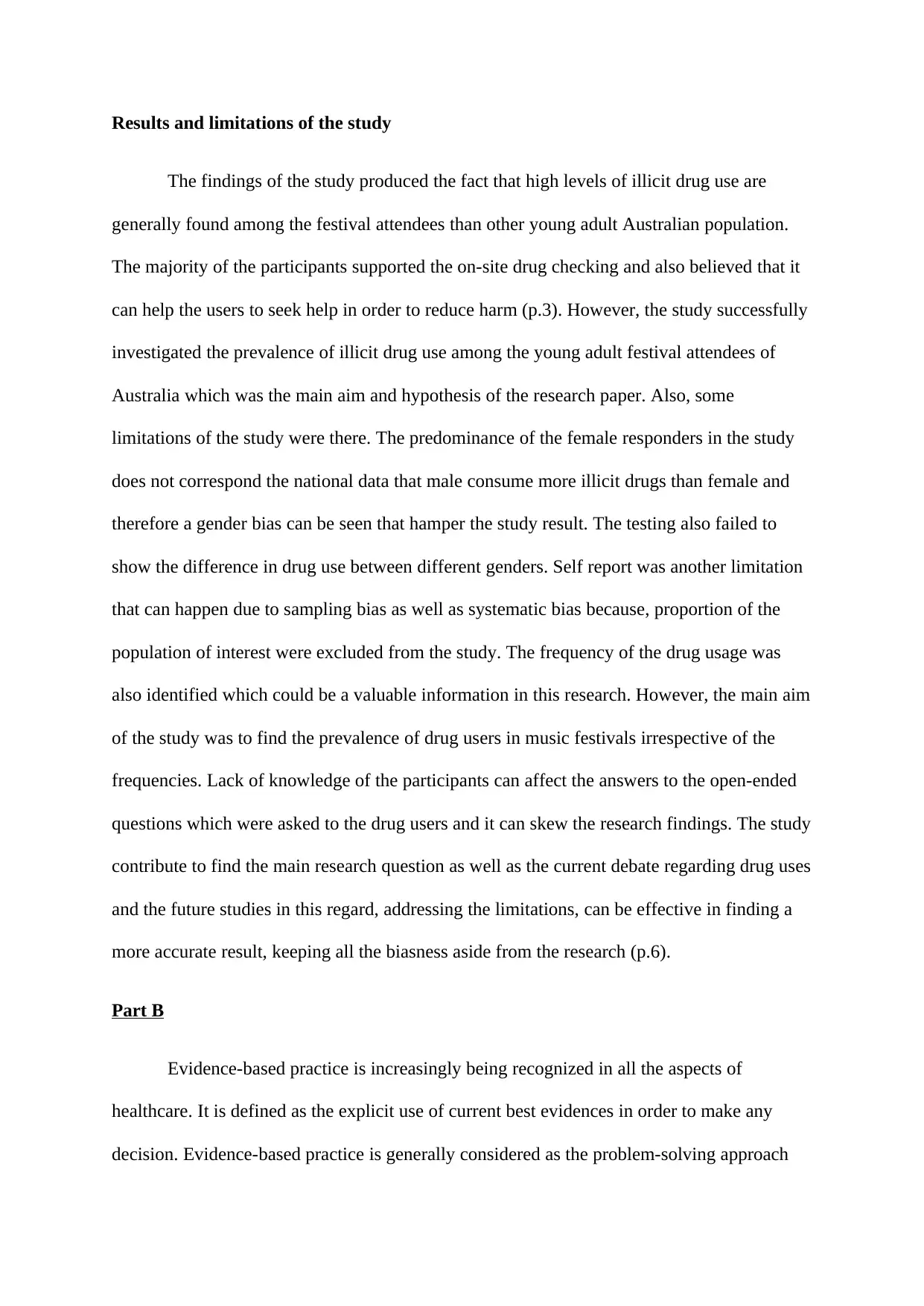
Results and limitations of the study
The findings of the study produced the fact that high levels of illicit drug use are
generally found among the festival attendees than other young adult Australian population.
The majority of the participants supported the on-site drug checking and also believed that it
can help the users to seek help in order to reduce harm (p.3). However, the study successfully
investigated the prevalence of illicit drug use among the young adult festival attendees of
Australia which was the main aim and hypothesis of the research paper. Also, some
limitations of the study were there. The predominance of the female responders in the study
does not correspond the national data that male consume more illicit drugs than female and
therefore a gender bias can be seen that hamper the study result. The testing also failed to
show the difference in drug use between different genders. Self report was another limitation
that can happen due to sampling bias as well as systematic bias because, proportion of the
population of interest were excluded from the study. The frequency of the drug usage was
also identified which could be a valuable information in this research. However, the main aim
of the study was to find the prevalence of drug users in music festivals irrespective of the
frequencies. Lack of knowledge of the participants can affect the answers to the open-ended
questions which were asked to the drug users and it can skew the research findings. The study
contribute to find the main research question as well as the current debate regarding drug uses
and the future studies in this regard, addressing the limitations, can be effective in finding a
more accurate result, keeping all the biasness aside from the research (p.6).
Part B
Evidence-based practice is increasingly being recognized in all the aspects of
healthcare. It is defined as the explicit use of current best evidences in order to make any
decision. Evidence-based practice is generally considered as the problem-solving approach
The findings of the study produced the fact that high levels of illicit drug use are
generally found among the festival attendees than other young adult Australian population.
The majority of the participants supported the on-site drug checking and also believed that it
can help the users to seek help in order to reduce harm (p.3). However, the study successfully
investigated the prevalence of illicit drug use among the young adult festival attendees of
Australia which was the main aim and hypothesis of the research paper. Also, some
limitations of the study were there. The predominance of the female responders in the study
does not correspond the national data that male consume more illicit drugs than female and
therefore a gender bias can be seen that hamper the study result. The testing also failed to
show the difference in drug use between different genders. Self report was another limitation
that can happen due to sampling bias as well as systematic bias because, proportion of the
population of interest were excluded from the study. The frequency of the drug usage was
also identified which could be a valuable information in this research. However, the main aim
of the study was to find the prevalence of drug users in music festivals irrespective of the
frequencies. Lack of knowledge of the participants can affect the answers to the open-ended
questions which were asked to the drug users and it can skew the research findings. The study
contribute to find the main research question as well as the current debate regarding drug uses
and the future studies in this regard, addressing the limitations, can be effective in finding a
more accurate result, keeping all the biasness aside from the research (p.6).
Part B
Evidence-based practice is increasingly being recognized in all the aspects of
healthcare. It is defined as the explicit use of current best evidences in order to make any
decision. Evidence-based practice is generally considered as the problem-solving approach
Paraphrase This Document
Need a fresh take? Get an instant paraphrase of this document with our AI Paraphraser
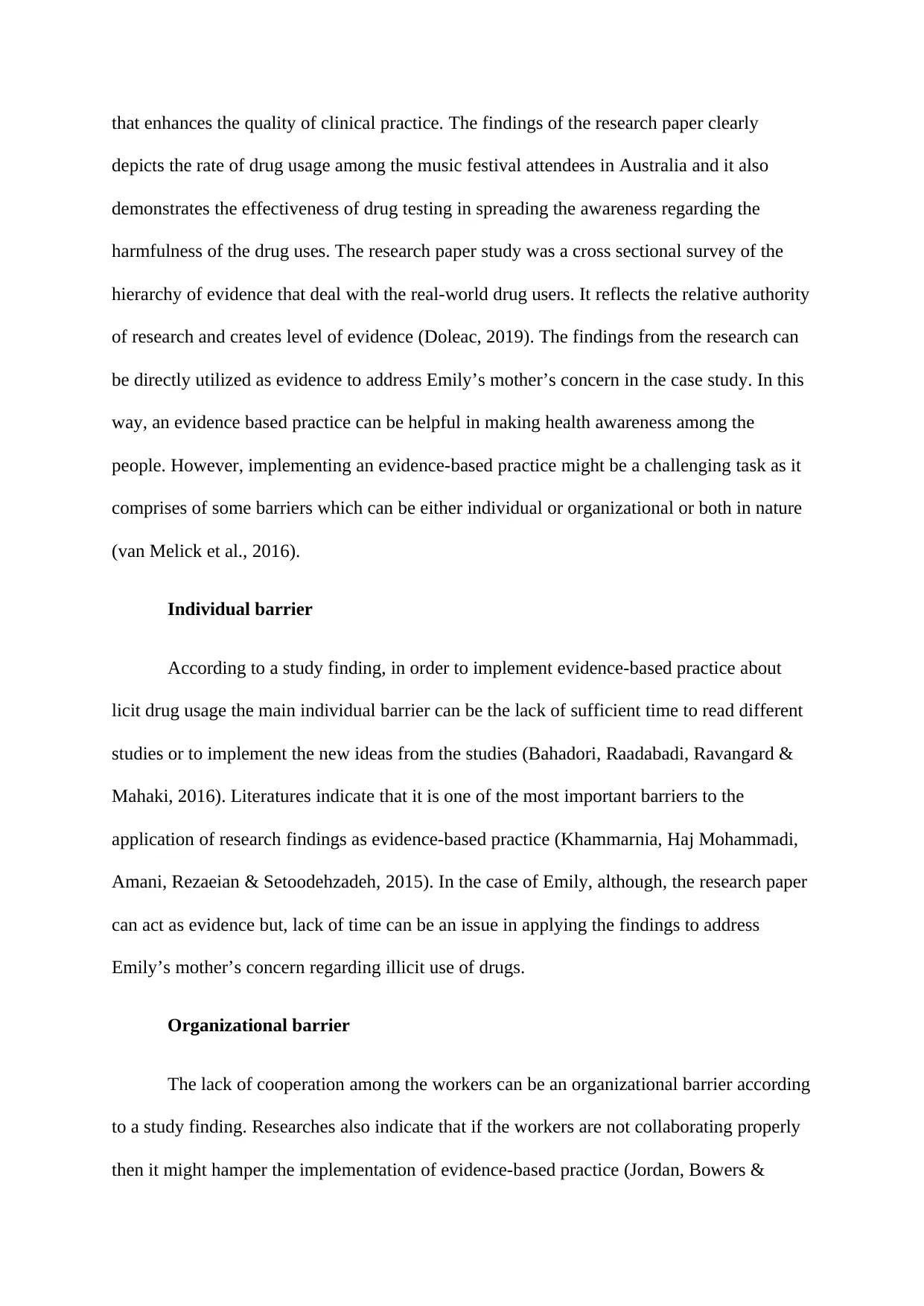
that enhances the quality of clinical practice. The findings of the research paper clearly
depicts the rate of drug usage among the music festival attendees in Australia and it also
demonstrates the effectiveness of drug testing in spreading the awareness regarding the
harmfulness of the drug uses. The research paper study was a cross sectional survey of the
hierarchy of evidence that deal with the real-world drug users. It reflects the relative authority
of research and creates level of evidence (Doleac, 2019). The findings from the research can
be directly utilized as evidence to address Emily’s mother’s concern in the case study. In this
way, an evidence based practice can be helpful in making health awareness among the
people. However, implementing an evidence-based practice might be a challenging task as it
comprises of some barriers which can be either individual or organizational or both in nature
(van Melick et al., 2016).
Individual barrier
According to a study finding, in order to implement evidence-based practice about
licit drug usage the main individual barrier can be the lack of sufficient time to read different
studies or to implement the new ideas from the studies (Bahadori, Raadabadi, Ravangard &
Mahaki, 2016). Literatures indicate that it is one of the most important barriers to the
application of research findings as evidence-based practice (Khammarnia, Haj Mohammadi,
Amani, Rezaeian & Setoodehzadeh, 2015). In the case of Emily, although, the research paper
can act as evidence but, lack of time can be an issue in applying the findings to address
Emily’s mother’s concern regarding illicit use of drugs.
Organizational barrier
The lack of cooperation among the workers can be an organizational barrier according
to a study finding. Researches also indicate that if the workers are not collaborating properly
then it might hamper the implementation of evidence-based practice (Jordan, Bowers &
depicts the rate of drug usage among the music festival attendees in Australia and it also
demonstrates the effectiveness of drug testing in spreading the awareness regarding the
harmfulness of the drug uses. The research paper study was a cross sectional survey of the
hierarchy of evidence that deal with the real-world drug users. It reflects the relative authority
of research and creates level of evidence (Doleac, 2019). The findings from the research can
be directly utilized as evidence to address Emily’s mother’s concern in the case study. In this
way, an evidence based practice can be helpful in making health awareness among the
people. However, implementing an evidence-based practice might be a challenging task as it
comprises of some barriers which can be either individual or organizational or both in nature
(van Melick et al., 2016).
Individual barrier
According to a study finding, in order to implement evidence-based practice about
licit drug usage the main individual barrier can be the lack of sufficient time to read different
studies or to implement the new ideas from the studies (Bahadori, Raadabadi, Ravangard &
Mahaki, 2016). Literatures indicate that it is one of the most important barriers to the
application of research findings as evidence-based practice (Khammarnia, Haj Mohammadi,
Amani, Rezaeian & Setoodehzadeh, 2015). In the case of Emily, although, the research paper
can act as evidence but, lack of time can be an issue in applying the findings to address
Emily’s mother’s concern regarding illicit use of drugs.
Organizational barrier
The lack of cooperation among the workers can be an organizational barrier according
to a study finding. Researches also indicate that if the workers are not collaborating properly
then it might hamper the implementation of evidence-based practice (Jordan, Bowers &
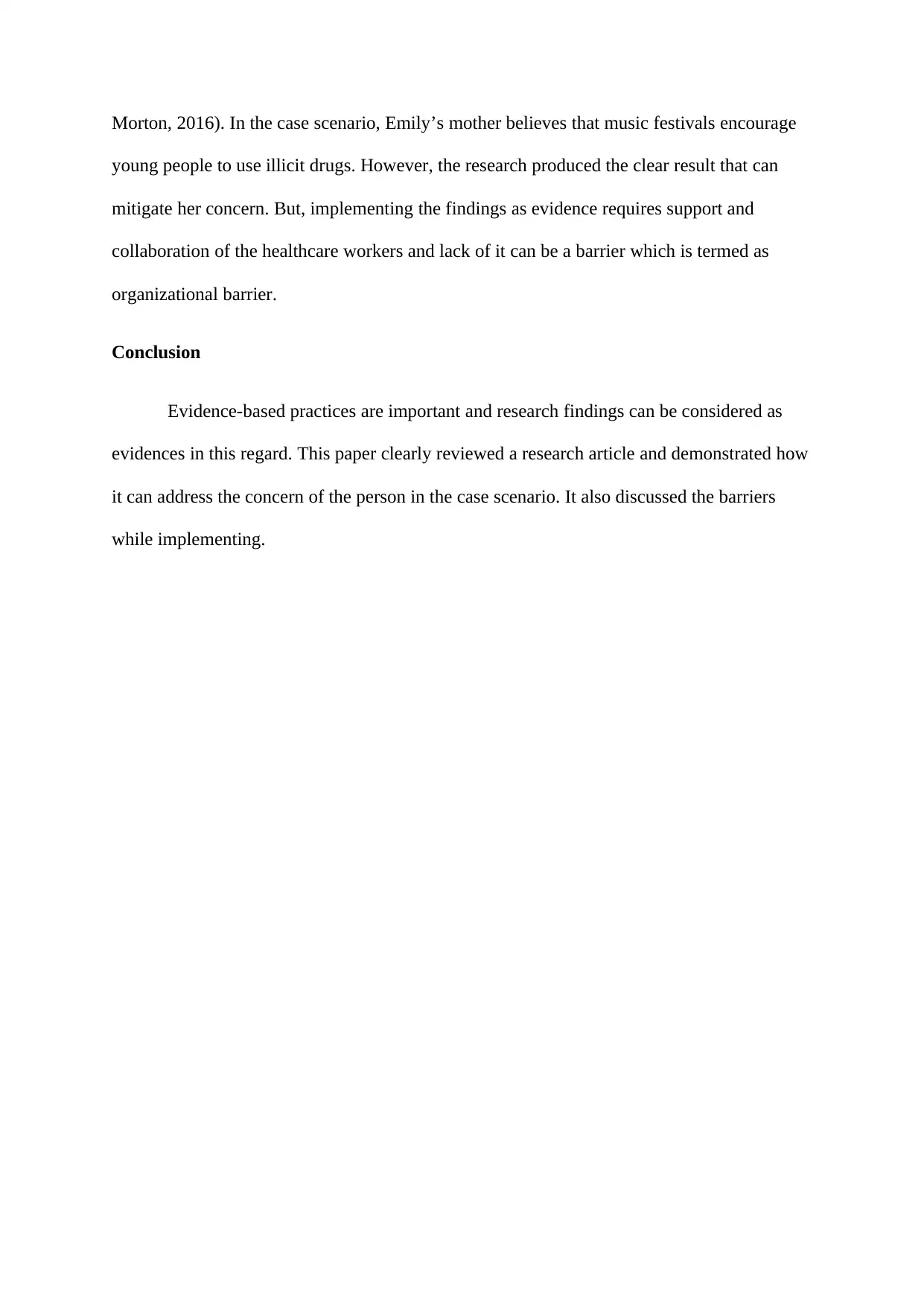
Morton, 2016). In the case scenario, Emily’s mother believes that music festivals encourage
young people to use illicit drugs. However, the research produced the clear result that can
mitigate her concern. But, implementing the findings as evidence requires support and
collaboration of the healthcare workers and lack of it can be a barrier which is termed as
organizational barrier.
Conclusion
Evidence-based practices are important and research findings can be considered as
evidences in this regard. This paper clearly reviewed a research article and demonstrated how
it can address the concern of the person in the case scenario. It also discussed the barriers
while implementing.
young people to use illicit drugs. However, the research produced the clear result that can
mitigate her concern. But, implementing the findings as evidence requires support and
collaboration of the healthcare workers and lack of it can be a barrier which is termed as
organizational barrier.
Conclusion
Evidence-based practices are important and research findings can be considered as
evidences in this regard. This paper clearly reviewed a research article and demonstrated how
it can address the concern of the person in the case scenario. It also discussed the barriers
while implementing.
⊘ This is a preview!⊘
Do you want full access?
Subscribe today to unlock all pages.

Trusted by 1+ million students worldwide
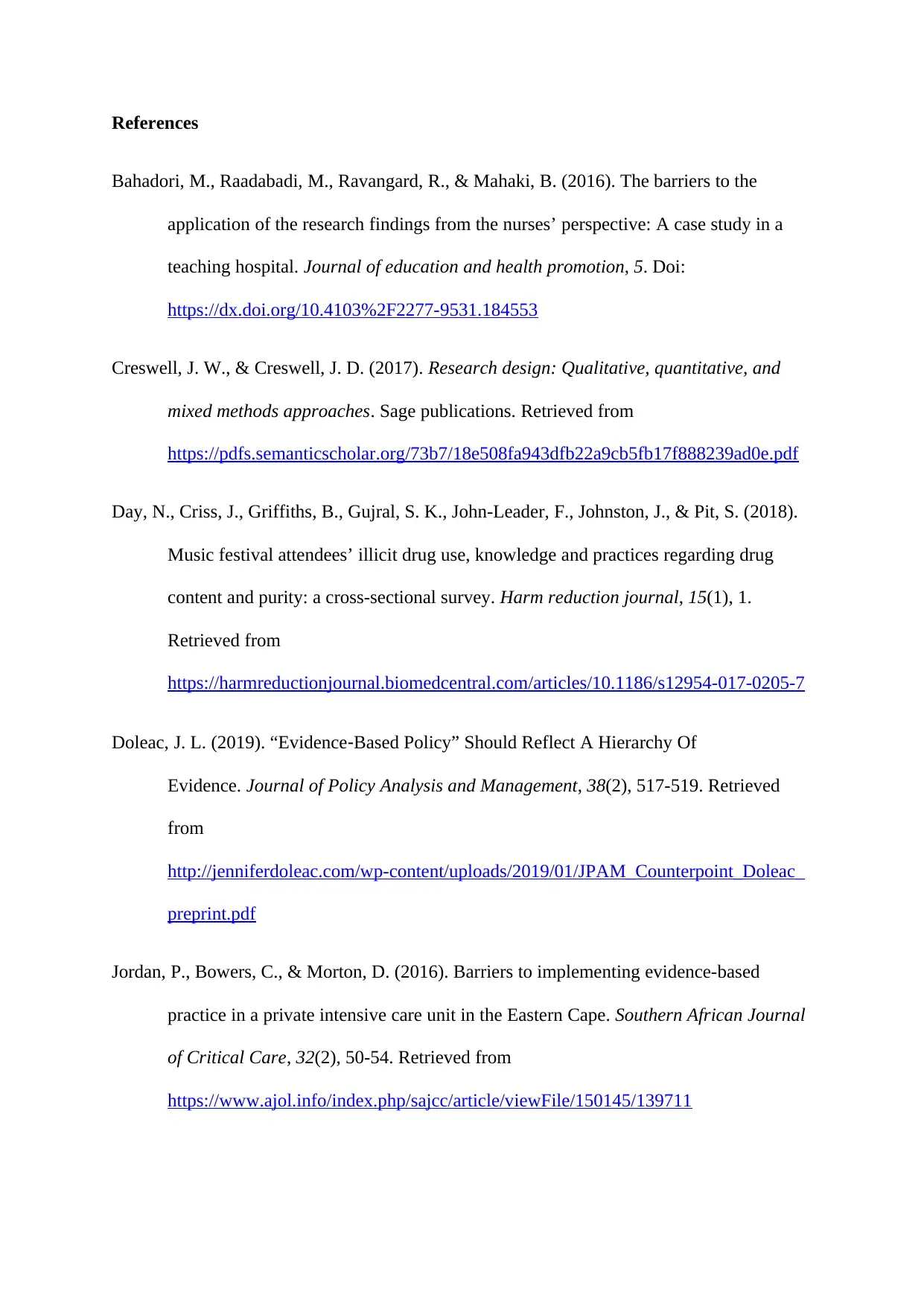
References
Bahadori, M., Raadabadi, M., Ravangard, R., & Mahaki, B. (2016). The barriers to the
application of the research findings from the nurses’ perspective: A case study in a
teaching hospital. Journal of education and health promotion, 5. Doi:
https://dx.doi.org/10.4103%2F2277-9531.184553
Creswell, J. W., & Creswell, J. D. (2017). Research design: Qualitative, quantitative, and
mixed methods approaches. Sage publications. Retrieved from
https://pdfs.semanticscholar.org/73b7/18e508fa943dfb22a9cb5fb17f888239ad0e.pdf
Day, N., Criss, J., Griffiths, B., Gujral, S. K., John-Leader, F., Johnston, J., & Pit, S. (2018).
Music festival attendees’ illicit drug use, knowledge and practices regarding drug
content and purity: a cross-sectional survey. Harm reduction journal, 15(1), 1.
Retrieved from
https://harmreductionjournal.biomedcentral.com/articles/10.1186/s12954-017-0205-7
Doleac, J. L. (2019). “Evidence‐Based Policy” Should Reflect A Hierarchy Of
Evidence. Journal of Policy Analysis and Management, 38(2), 517-519. Retrieved
from
http://jenniferdoleac.com/wp-content/uploads/2019/01/JPAM_Counterpoint_Doleac_
preprint.pdf
Jordan, P., Bowers, C., & Morton, D. (2016). Barriers to implementing evidence-based
practice in a private intensive care unit in the Eastern Cape. Southern African Journal
of Critical Care, 32(2), 50-54. Retrieved from
https://www.ajol.info/index.php/sajcc/article/viewFile/150145/139711
Bahadori, M., Raadabadi, M., Ravangard, R., & Mahaki, B. (2016). The barriers to the
application of the research findings from the nurses’ perspective: A case study in a
teaching hospital. Journal of education and health promotion, 5. Doi:
https://dx.doi.org/10.4103%2F2277-9531.184553
Creswell, J. W., & Creswell, J. D. (2017). Research design: Qualitative, quantitative, and
mixed methods approaches. Sage publications. Retrieved from
https://pdfs.semanticscholar.org/73b7/18e508fa943dfb22a9cb5fb17f888239ad0e.pdf
Day, N., Criss, J., Griffiths, B., Gujral, S. K., John-Leader, F., Johnston, J., & Pit, S. (2018).
Music festival attendees’ illicit drug use, knowledge and practices regarding drug
content and purity: a cross-sectional survey. Harm reduction journal, 15(1), 1.
Retrieved from
https://harmreductionjournal.biomedcentral.com/articles/10.1186/s12954-017-0205-7
Doleac, J. L. (2019). “Evidence‐Based Policy” Should Reflect A Hierarchy Of
Evidence. Journal of Policy Analysis and Management, 38(2), 517-519. Retrieved
from
http://jenniferdoleac.com/wp-content/uploads/2019/01/JPAM_Counterpoint_Doleac_
preprint.pdf
Jordan, P., Bowers, C., & Morton, D. (2016). Barriers to implementing evidence-based
practice in a private intensive care unit in the Eastern Cape. Southern African Journal
of Critical Care, 32(2), 50-54. Retrieved from
https://www.ajol.info/index.php/sajcc/article/viewFile/150145/139711
Paraphrase This Document
Need a fresh take? Get an instant paraphrase of this document with our AI Paraphraser
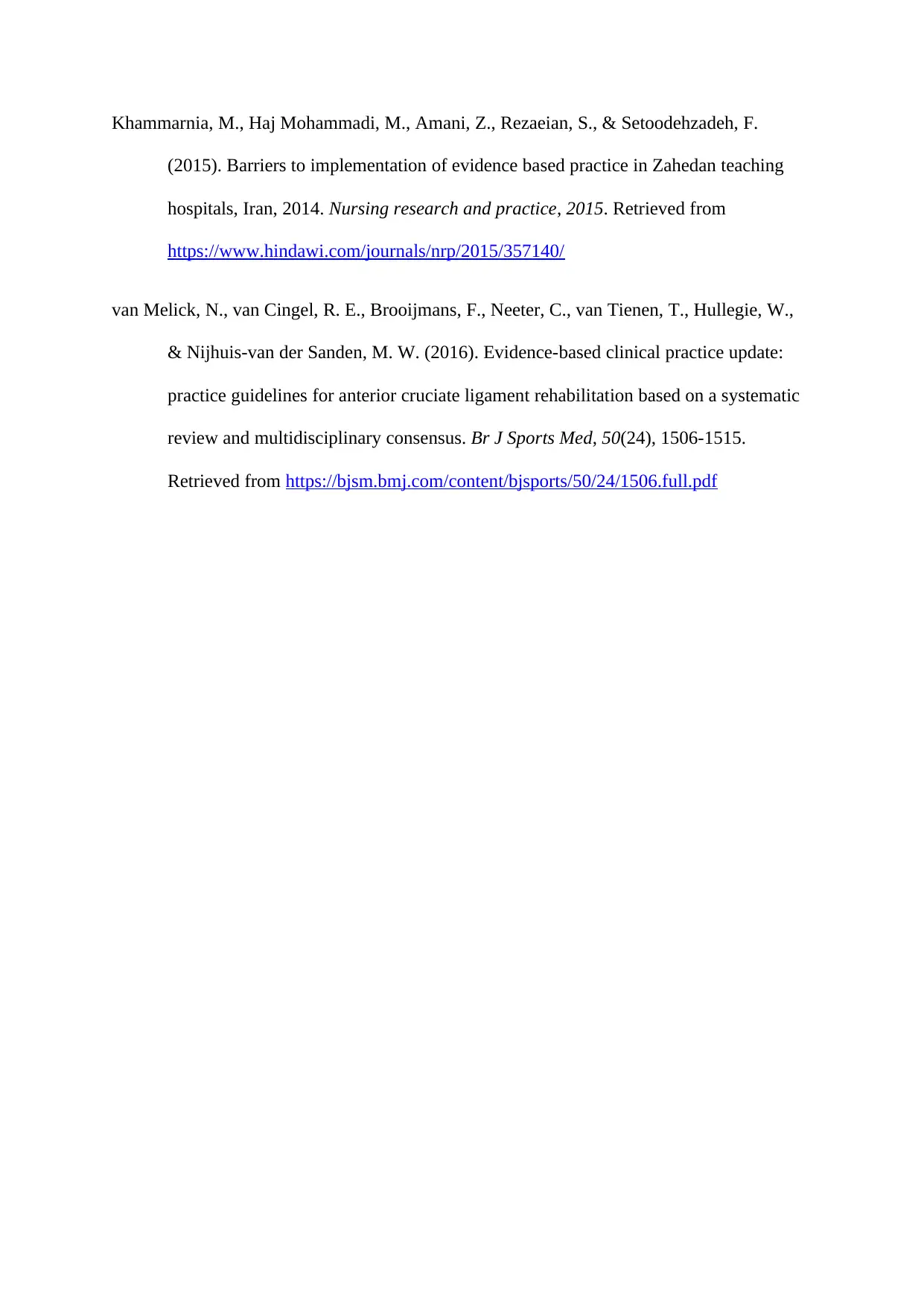
Khammarnia, M., Haj Mohammadi, M., Amani, Z., Rezaeian, S., & Setoodehzadeh, F.
(2015). Barriers to implementation of evidence based practice in Zahedan teaching
hospitals, Iran, 2014. Nursing research and practice, 2015. Retrieved from
https://www.hindawi.com/journals/nrp/2015/357140/
van Melick, N., van Cingel, R. E., Brooijmans, F., Neeter, C., van Tienen, T., Hullegie, W.,
& Nijhuis-van der Sanden, M. W. (2016). Evidence-based clinical practice update:
practice guidelines for anterior cruciate ligament rehabilitation based on a systematic
review and multidisciplinary consensus. Br J Sports Med, 50(24), 1506-1515.
Retrieved from https://bjsm.bmj.com/content/bjsports/50/24/1506.full.pdf
(2015). Barriers to implementation of evidence based practice in Zahedan teaching
hospitals, Iran, 2014. Nursing research and practice, 2015. Retrieved from
https://www.hindawi.com/journals/nrp/2015/357140/
van Melick, N., van Cingel, R. E., Brooijmans, F., Neeter, C., van Tienen, T., Hullegie, W.,
& Nijhuis-van der Sanden, M. W. (2016). Evidence-based clinical practice update:
practice guidelines for anterior cruciate ligament rehabilitation based on a systematic
review and multidisciplinary consensus. Br J Sports Med, 50(24), 1506-1515.
Retrieved from https://bjsm.bmj.com/content/bjsports/50/24/1506.full.pdf
1 out of 8
Related Documents
Your All-in-One AI-Powered Toolkit for Academic Success.
+13062052269
info@desklib.com
Available 24*7 on WhatsApp / Email
![[object Object]](/_next/static/media/star-bottom.7253800d.svg)
Unlock your academic potential
Copyright © 2020–2025 A2Z Services. All Rights Reserved. Developed and managed by ZUCOL.





